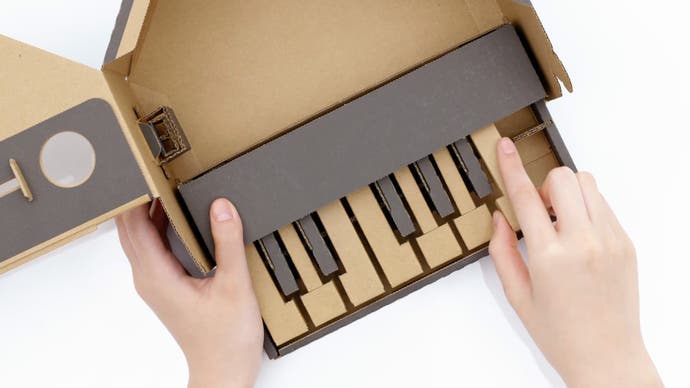Labo is the most Nintendo thing to come from the company in generations
This is cardcore.
One of the very best things about Labo, having spent a few hours tinkering with Nintendo's new DIY cardboard toy-set for the Switch, is also one of the most pointless. Build the radio control car - a process which takes just under 10 minutes, or over an hour if you want to go wild with the crayons afterwards - and you'll notice one final piece of cardboard that's left over. Fold the small flaps at either end, then pop the slim piece on top of your Switch's screen, sliding those tabs down into the Joy-Con rails. And voila - you've just installed an aerial so that now you can properly play with the RC car you've just built.
It's completely useless - unless there's some dark art going on I'm unaware of, that single piece of cardboard isn't sending signals from your Switch to the RC car - but it's also essential to the magic of Labo. Put your dry questions and concerns about what is what isn't a video game to the side for one moment, and lean on your imagination a little. Just play along.
Labo is a thing of wonder, belonging to a lineage that's arguably Nintendo's most fascinating. This isn't the next Mario, Zelda or Metroid; instead, it's a successor to the likes of Mario Paint, Brain Age, Electroplankton and Pictochat. Look even further back, and Labo has a direct link back to the Love Tester, the Ultra Hand and all those other glorious contraptions that came out of Gunpei Yokoi's laboratory in those pre-video game years when Nintendo was first and foremost a toymaker.
Placed in contemporary context it can all feel more than a little out of place. To come along to a party where the others are fronting off about pixel counts armed with little more than a few sheets of cardboard is bold and brilliantly disruptive. Coming off the back of the Switch's exceptional first year, it's hardly what you'd expect, though it is exactly the kind of thing you'd want from a company with as rich a history of flipping the table as Nintendo.
Rifle through what's in the box and it's clear that, despite the move to cardboard, it all feels extremely Nintendo. Maybe that's no surprise, given the company's history with the medium - as Nintendo hardware lead Yoshiyasu Ogasawara points out in these brilliant interviews, they've been designing product packaging for years, and for well over a hundred years it's been manufacturing hanafuda cards, the iconic Daitouryou even making a cameo in the interior of the Labo house. There's a playful robustness to the cardboard toys, an ingenuity of design in how they all fold together without the need for tape or glue. Each is a marvel of engineering, a marvel that's all the more explicit given how you're invited to take part in their creation.
In the detail, they come alive - the squishy cardboard springs of the house, for example, or the click, click, click of the fishing rod as you reel in your catch. After only a short while with it all, I'm still not entirely sure the software is a match for the hardware - the motorbike game is fun but throwaway, an accusation you could just as easily level at the fishing game and, more damningly, the expensive add-on that is the robot pack, but that's not where the real magic of Labo lies.

The real magic comes from the creativity Labo enables. Let's start with the piano - itself a fine tool, complete with a pitch bend lever, effects knobs and even the means to create your own waveforms, punching them in manually by inserting a piece of card - which is already being used to cover various Nintendo themes. Beyond that, though, is where it gets really exciting. The Garage part of Labo - a kind of stripped back programming, whereby you're tailoring inputs and outputs until you've woven a whole intricate web of logic gates - unleashes some fascinating possibilities, all of which are only started to be hinted at right now. Turn the inputs from the giant robot into musical outputs and you can become a huge, stomping one man band - Dick van Dyke from Mary Poppins, weaponised by cardboard, if you will. Take a Joy Con and turn it into a composer's baton, shifting pitch and tone of your own compositions. Or just figure out how to do your own cover of the Wii's shopping channel music.
When paired with a decent imagination and a bit of graft, some really special things could happen. There's another lineage that Labo could tap into, and it's positioning itself in the rich history of Nintendo hardware that's been brilliantly subverted; think Kraftwerk's modified Power Glove MIDI controller, or DJ Scotch Egg's incredible Game Boy-powered gabba sets. Labo, with its DIY ethos, positively invites such unexpected uses, and the real fun with it all has only just started.
And so Labo is one of those oddities that occasionally emerges from Nintendo, an experiment that could go unloved or one that could go on to change the world of gaming. It's too early to say exactly which camp it will fall in - everything about its launch suggests that Nintendo is currently opting for a soft release, laying the groundwork for the proper push later this year - but judging from the first few hours, one thing's clear. This is just about the purest expression of Nintendo magic there's been for generations.










